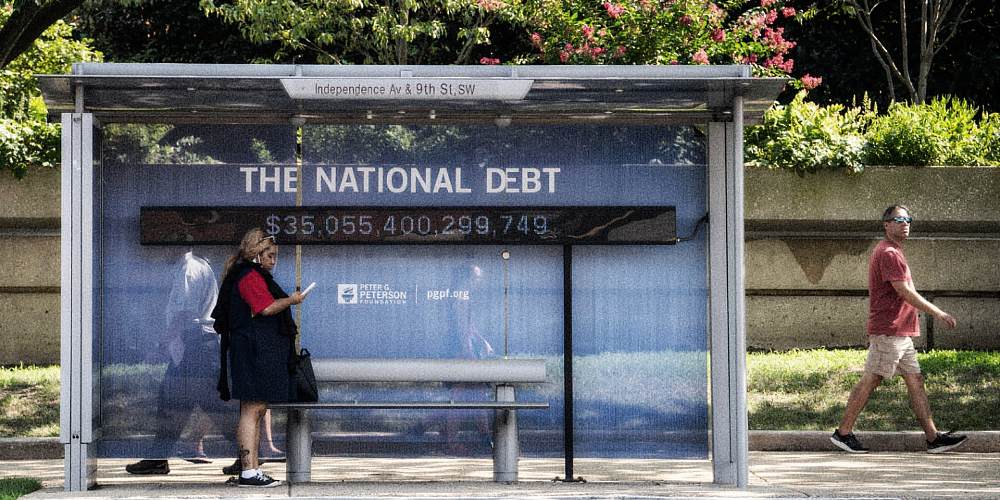(The Epoch Times)—The U.S. gross national debt surpassed $36 trillion on Thursday, according to Treasury data, while a Federal Reserve report showed intensifying concern about America’s fiscal health and its broader implications for financial stability.
The massive debt milestone was reached just over three months after the previous $35 trillion benchmark, highlighting the rapid accumulation of federal borrowing in recent years. It comes as policymakers brace for renewed debates over spending and taxation, with the incoming Trump administration and the 119th Congress having to contend with the nation’s fiscal trajectory.
“As if lawmakers needed any other reasons to take America’s fiscal health seriously, the gross national debt of the United States has now officially reached $36 trillion,” Maya MacGuineas, president of the Committee for a Responsible Federal Budget (CRFB), said in a statement. “Government borrowing is becoming as certain as the changing of the seasons these days.”
MacGuineas highlighted the risks of rising debt, including slower economic growth, higher inflation, and increased interest rates. She warned that high debt loads constrain fiscal flexibility, hampering the government’s ability to respond to economic downturns or global crises, pointing to $13 trillion in projected interest payments over the next decade as a stark example.
“The incoming Trump Administration and Members of the 119th Congress face several fiscal hurdles from the moment they take office–starting with the reinstatement of the debt ceiling in January and a $1.7 trillion PAYGO scorecard waiting to greet them,” MacGuineas said. “The way they approach that and other crucial decisions ahead like the expiration of discretionary spending caps and the 2017 tax cuts, as well as how they choose to offset the costs of their new policies, will determine our fiscal health for a long time.”
Meanwhile, respondents to a New York Federal Reserve survey that was cited in the Fed’s newly released semi-annual Financial Stability Report identified U.S. fiscal debt sustainability as the most frequently cited near-term risk to financial stability, overtaking concerns about persistent inflation and monetary tightening.
“Concerns surrounding US fiscal debt sustainability were atop the list this survey, followed by escalating tensions in the Middle East and policy uncertainty,” the report’s authors wrote. Fears of a potential U.S. recession and a global trade war also moved up in importance in the latest survey compared to the one carried out in spring.
In the Fed’s discussion of the near-term risks identified in the survey, which was conducted among some two dozen financial sector participants and observers from August to October, the central bank noted that rising geopolitical tensions and potential economic slowdowns could amplify vulnerabilities tied to the nation’s fiscal challenges and lead to “broad adverse spillovers.”
Escalation in conflicts such as the Middle East crisis or the war in Ukraine could disrupt global energy and commodity markets, triggering inflationary pressures and heightened market volatility. The Fed also warned of the potential for a sharp downturn in economic growth, which could lead to steep corrections in asset prices, particularly in overvalued sectors like equities and real estate.
High levels of corporate and nonbank financial institution leverage could exacerbate financial stress, while elevated public debt might limit the government’s ability to respond effectively to such shocks, the report’s authors noted. Further, the report underscored the growing risk of cyberattacks, which could disrupt the financial system by exploiting interdependencies among institutions and components of market infrastructure.
The Fed’s own financial stability assessment focused on a framework of risks across four key areas: asset valuations, borrowing by households and businesses, leverage in the financial sector, and funding risks.
The report noted that asset values “remained elevated,” with liquidity in financial markets remaining low, raising the risk of strain during periods of volatility. Vulnerabilities from business and household debt were described as “moderate,” though delinquencies in auto and credit card loans were elevated.
The banking system was described in the financial stability report as “sound and resilient,” though banks’ market-adjusted capital levels improved only “modestly” and so remain sensitive to interest rate changes. Hedge fund leverage was at its highest level in over a decade, while vulnerabilities in some short-term investment vehicles continued to grow.
What Would You Do If Pharmacies Couldn’t Provide You With Crucial Medications or Antibiotics?
The medication supply chain from China and India is more fragile than ever since Covid. The US is not equipped to handle our pharmaceutical needs. We’ve already seen shortages with antibiotics and other medications in recent months and pharmaceutical challenges are becoming more frequent today.
Our partners at Jase Medical offer a simple solution for Americans to be prepared in case things go south. Their “Jase Case” gives Americans emergency antibiotics they can store away while their “Jase Daily” offers a wide array of prescription drugs to treat the ailments most common to Americans.
They do this through a process that embraces medical freedom. Their secure online form allows board-certified physicians to prescribe the needed drugs. They are then delivered directly to the customer from their pharmacy network. The physicians are available to answer treatment related questions.



